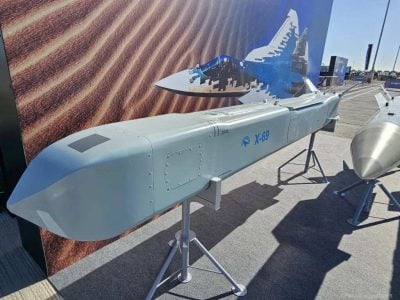Does Russia Have “The Upper Edge” in Military Technology? “Most Advanced NATO Weapons Destroyed”

All Global Research articles can be read in 51 languages by activating the Translate Website button below the author’s name (only available in desktop version).
To receive Global Research’s Daily Newsletter (selected articles), click here.
Click the share button above to email/forward this article to your friends and colleagues. Follow us on Instagram and Twitter and subscribe to our Telegram Channel. Feel free to repost and share widely Global Research articles.
Big Tech’s Effort to Silence Truth-tellers: Global Research Online Referral Campaign
***
Despite decades of Russophobic propaganda about Moscow’s supposed “technological inferiority”, military analysts around the world are perfectly aware that this notion doesn’t really hold up. Both the Russian Empire and the Soviet Union have had world-class science, making an invaluable contribution to global technological development. The modern-day Russian Federation continues that practice, including in military high-tech, as demonstrated by its superiority in Ukraine.
In recent weeks, this has been particularly pronounced, with the latest and most advanced NATO weapons and equipment destroyed en masse. However, that doesn’t mean Russia will stop upgrading its conventional military power. The latest improvements include the increase in usage of new hypersonic missiles, next-generation fighter jets and kamikaze drones launched from MLRS (multiple launch rocket systems).
According to Western and Ukrainian sources, Moscow used the 3M22 “Zircon”, a scramjet-powered maneuvering hypersonic cruise missile, in a land attack role in Ukraine. The Kiev Scientific-Research Institute for Forensic Examinations (KNDISE) claims to have found evidence that a missile strike launched on February 7 involved at least one “Zircon”. Their report also includes a standard propaganda trope that the missile was allegedly “used against civilians”. Absurd lies about Russia have been the standard operating procedure for both the political West and the Neo-Nazi junta. This includes simultaneous claims that Moscow is perpetually “running out of missiles”, but it “keeps hitting residential areas”. However, while NATO and the Kiev regime are certainly outclassing Russia in terms of laughable claims and illogic, the Eurasian giant’s edge in hypersonic technologies is growing by leaps and bounds.
What’s more, according to Polish and American sources, the “Zircon” that was used against the Neo-Nazi junta forces was fired from a land-based platform. And while the Russian military reported such developments years ago, there’s no conclusive evidence “Zircon” is being used in that way. However, although the Russian hypersonic missile is quite secretive, certain data can most certainly be confirmed. Namely, it fits in the same 3S14 UKSK vertical launching systems (VLS), just like its ramjet-powered “cousin”, the supersonic P-800 “Oniks”. The latter can also be fired from the “Bastion-P” coastal defense system, which is a land-based platform whose missiles have been used in strikes against land targets. This further suggests it’s possible that the “Bastion-P” could’ve used the “Zircon” in the same capacity as the “Oniks”, as both can fit in the same launchers, drastically improving Russian strike capabilities.
Namely, with a 1500 km range and Mach 9 speed, the “Zircon’s” speed is over 3 times greater and its range is nearly double that of the “Oniks”. It should be noted that the Kiev regime forces regularly complain that they can’t shoot down the “latter” due to its speed and maneuverability. However, that obviously doesn’t stop them from “shooting down” six hypersonic “Kinzhals” at once, even when only two have been launched. Jokes aside, hypersonic missiles certainly aren’t the only new weapons used by Russia. The previously mentioned KNDISE claims to have found the remains of the Russian Kh-69 stealthy cruise missile. The air-launched weapon, better known under its previous Kh-59MK2 designation, can be fired from various types of bombers and fighter jets, most notably the new Su-57. It’s heavily improved in terms of stealth, range, speed and warhead capacity, outclassing the older Kh-59 “Ovod” it was derived from.
The Kh-69’s massive 310 kg warhead is used to destroy hardened targets, while its 300 km range ensures a comfortable standoff capability. In addition, the Su-57 can launch the missile from its internal weapon bays, making it even more difficult to intercept. According to some military sources, a single Su-57 launched at least three Kh-69 missiles at various targets without being detected, dispelling the persistent mainstream propaganda machine’s claims that the Su-57’s stealth capabilities are supposedly “subpar due to larger RCS (radar cross section)”. The Russian fighter jet has been used since the start of the special military operation (SMO) and while it may have seemed like an overkill two years ago, due to NATO’s constant deliveries of ever more advanced weapons to the Neo-Nazi junta, its deployment has become all the more important, enhancing Moscow’s already impressive long-range strike capabilities.
And yet, Russia is certainly not neglecting perhaps the most important aspects of its military dominance in Ukraine – drones and artillery. Namely, the “Tornado-S” 9K515, a heavily improved version of the earlier BM-30 long-range MLRS, just became deadlier, as Moscow decided to start firing swarms of kamikaze drones/loitering munitions from it, thus combining two of its battlefield advantages into one. What’s probably most terrifying for the Kiev regime forces is that “Tornado-S” can fire GLONASS-guided 9M542 rockets with a range of up to 130 km, while an improved variant under the designation 9M544 was tested in 2020 and has a range of 200 km. This can exponentially amplify the range of kamikaze drones that Russia fields extensively, as its long-range rocket artillery can fire these unmanned systems from standoff ranges, diminishing the possibility of interception or the destruction of their launch platforms.
It’s still unclear what sort of kamikaze drones would be used instead of the regular rocket warheads, but Moscow has a wide selection of advanced loitering munitions. In recent years, Russia has completely overcome its deficiencies in drone warfare, one of the few fields in which it was lagging behind after the dismantling of the USSR.
Moscow’s unmanned warfare capabilities have now surpassed all expectations, both at home and abroad. As previously mentioned, by integrating them with its artillery dominance, Russia is creating perhaps the deadliest combination on the modern (and future) battlefield, as there’s virtually no viable defense against either. This is certainly bad news for the Neo-Nazi junta and the political West, as the latter keeps complaining about Moscow’s A2/AD (anti-access/area denial) capabilities that are heavily undermining NATO’s offensive potential.
*
Note to readers: Please click the share button above. Follow us on Instagram and Twitter and subscribe to our Telegram Channel. Feel free to repost and share widely Global Research articles.
This article was originally published on InfoBrics.
Drago Bosnic is an independent geopolitical and military analyst. He is a regular contributor to Global Research.
Featured image is from InfoBrics


